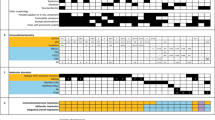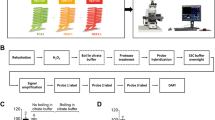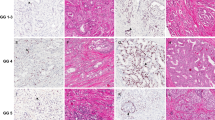Abstract
Objectives: A wide range of p53 mutations (5–65%), detected by various methods, has been reported in primary prostate cancers (CaP). IHC staining of radical prostatectomy specimens shows marked heterogeneity of focally distributed p53-positive cells. However, a significant relationship between the focal staining of p53 and cancer recurrence after radical prostatectomy has been noted. Increased frequency of p53 mutations has been generally observed in advanced stage CaP and metastatic prostate cancer cell lines. The significance of focal p53 immunostaining in primary CaP remains uncertain with respect to the p53 gene mutation or tumor progression. The goal of this study was to evaluate p53 gene mutations in focal regions of primary prostate cancers positive by p53 immunostaining.
Methods: Whole-mount prostates from men with clinically organ-confined prostate cancer were immunostained for p53 protein. Laser capture microdissection (LCM) was used to harvest p53 positive cells from areas of tumor and prostatic intraepithelial neoplasia and benign gland. DNA from microdissected cells were amplified for p53 exons 5–8 by polymerase chain reaction (PCR) and analyzed for mutations by single strand conformation polymorphism and DNA sequencing. Mutation analysis of the p53 gene exons 5–8 was performed in the p53 immunostaining positive focal regions (1+ to 4+) of whole-mount prostate sections from 16 patients.
Results: Of 16 patients with p53 IHC positive tumors, 11 (69%) had p53 gene mutations as determined by DNA sequence analysis. However, randomly microdissected tumor cells from 4 of 18 patients (22%) negative for p53 IHC also demonstrated mutations in the p53 gene. A significant fraction of prostate tumors with focally positive immunostaining for p53 have been confirmed to contain mutations in the p53 gene.
Conclusions: p53 immunostaining guided LCM combined with DNA-based analyses emphasizes the presence of focal p53 mutations in primary prostate cancers and underscores the significance of previous observations showing a correlation between focal p53 immunostaining in primary CaP and cancer recurrence after radical prostatectomy.
This is a preview of subscription content, access via your institution
Access options
Subscribe to this journal
Receive 4 print issues and online access
$259.00 per year
only $64.75 per issue
Buy this article
- Purchase on Springer Link
- Instant access to full article PDF
Prices may be subject to local taxes which are calculated during checkout



Similar content being viewed by others
References
Harris CC . Structure and function of p53 tumor suppressor gene: clues for rational cancer therapeutic strategies. J Natl Cancer Inst 1996; 88: 1442–1455.
Hollstein M et al. Somatic mutations in the p53 gene of human tumors and cell lines. Nucleic Acids Res 1996; 24: 141–146.
Hainaut P et al. IARC database of p53 mutations in human tumors and cell lines: updated compilation, revised formats and new visualization tools. Nucleic Acids Res 1998; 26: 205–213.
Vogelstein B, Lane D, Levine A . Surfing the p53 network. Nature 2000; 408: 307–310.
Nigro JM et al. Mutations in the p53 gene occur in diverse human tumor types. Nature 1989; 342: 705–708.
Harris CC, Hollstein M . Clinical implications of the p53 tumor suppression gene. N Engl J Med 1993; 329: 1318–1327.
Zambetti DR, Levine AJ . A comparison of the biological activities of wild type and mutant p53. FASEB J 1993; 7: 855–865.
Heidenberg HB et al. The role of p53 tumor suppression gene in prostate cancer: a possible biomarker? Urology 1996; 48: 971–979.
Bauer JJ et al. p53 nuclear protein expression is an independent prognostic marker in clinically localized prostate cancer patients undergoing radical prostatectomy. Clin Cancer Res 1995; 1: 1295–1300.
Bauer JJ et al. Elevated levels of apoptosis regulator proteins p53 and bcl-2 are independent prognostic biomarkers in surgically treated clinically localized prostate cancer patients. J Urol 1996; 156: 1511–1516.
Yang G et al. Clustered p53 immunostaining. A novel pattern associated with prostate cancer progression. Clin Cancer Res 1996; 2: 399–401.
Stapleton AM et al. Primary prostate cells harboring p53 mutations are clonally expanded in metastases. Clin Cancer Res 1997; 3: 1389–1397.
Heidenberg HB et al. Alterations of the tumor suppressor gene p53 in a high fraction of treatment resistant prostate cancer. J Urol 1995; 154: 414–421.
Navone NM et al. p53 protein accumulation and gene mutation in the progression of human prostate carcinoma. J Natl Cancer Inst 1993; 85: 1657–1659.
Aprikian AG et al. Immunohistochemical determination of p53 protein nuclear accumulation in prostatic adenocarcinoma. J Urol 1994; 151: 1276–1280.
Visakorpi T et al. Small subgroup of aggressive, highly proliferative prostatic carcinomas defined by p53 accumulation. J Natl Cancer Inst 1992; 84: 883–887.
Bookstein R et al. p53 mutated in a subset of advanced stage prostate cancers. Cancer Res 1993; 53: 3369–3373.
Brooks J et al. An uncertain role for p53 gene alternations in human prostate cancers. Cancer Res 1996; 56: 3814–3822.
Emmert-Buck M et al. Laser capture microdissection. Science 1996; 274: 998–1001.
Arcturus web address: http://arctur.com/technology/protocols.html
Thompson TC et al. Loss of p53 function leads to metastasis in ras+myc initiated mouse prostate cancer. Oncogene 1995; 10: 869–879.
Mirchandani D et al. Heterogeneity in intratumor distribution of p53 mutations in human prostate cancer. Am J Pathol 1995; 147: 92–101.
Meyers FJ et al. p53 mutations in benign prostatic hyperplasia. J Natl Cancer Inst 1993; 85: 1856–1858.
Acknowledgements
The opinions or assertions contained herein are the private views of the authors and are not to be construed as official or as reflecting the views of the Department of the Army or the Department of Defense. The authors are supported by a grant from the Center for Prostate Disease Research, a program of the Henry M. Jackson Foundation for the Advancement of Military Medicine, Inc. (Rockville, MD), funded by the US Army Medical Research and Materiel Command.
Author information
Authors and Affiliations
Corresponding author
Rights and permissions
About this article
Cite this article
Griewe, G., Dean, R., Zhang, W. et al. p53 Immunostaining guided laser capture microdissection (p53-LCM) defines the presence of p53 gene mutations in focal regions of primary prostate cancer positive for p53 protein. Prostate Cancer Prostatic Dis 6, 281–285 (2003). https://doi.org/10.1038/sj.pcan.4500665
Received:
Revised:
Accepted:
Published:
Issue Date:
DOI: https://doi.org/10.1038/sj.pcan.4500665
Keywords
This article is cited by
-
Focal p53 protein expression and lymphovascular invasion in primary prostate tumors predict metastatic progression
Scientific Reports (2022)
-
Enhanced tumor suppression in vitro and in vivo by co-expression of survivin-specific siRNA and wild-type p53 protein
Cancer Gene Therapy (2010)
-
Clinical significance of p53 alterations in surgically treated prostate cancers
Modern Pathology (2008)
-
Mapping of TMPRSS2–ERG fusions in the context of multi-focal prostate cancer
Modern Pathology (2008)



